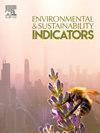A model for institutional phosphorus damage costs: A case study at the University of Virginia
IF 5.4
Q1 ENVIRONMENTAL SCIENCES
引用次数: 0
Abstract
Calculating environmental “damage costs” associated with resource use can help individuals, communities, and institutions inform and improve their sustainability efforts. Though damage cost estimates have been developed for carbon and nitrogen, there is little precedent for calculating damage costs relating to phosphorus. We demonstrate a method to estimate institutional phosphorus damage costs using a case study of the University of Virginia, a public university in the United States. Our methods determine the source (diffuse agricultural and wastewater point source) and location (coastal and freshwater) of the University’s phosphorus footprint impacts, estimate the relative contribution of nitrogen and phosphorus across existing eutrophication damage costs, and then apply the results to the University’s phosphorus footprint. We found that activities at the University result in approximately $76 000 of annual downstream costs to society due to its phosphorus footprint ($2.08/kg of phosphorus released to the environment). About 48% of those damages are incurred in the Chesapeake Bay, which flows into the Atlantic Ocean and is the largest estuary in the United States, while 7% are incurred in the Gulf of Mexico. The remainder (45%) of costs are incurred in freshwater systems across both watersheds. Our findings are likely an underestimate of true societal impacts, as impacts such as losses of ecosystem services are difficult to value. However, we emphasize that this method is transferable and can be used by other institutions to calculate their phosphorus damage costs, providing a more holistic accounting of downstream environmental impacts.
制度性磷损害成本模型:弗吉尼亚大学的案例研究
计算与资源使用相关的环境 "损害成本 "可以帮助个人、社区和机构了解并改进其可持续发展工作。虽然已经对碳和氮的损害成本进行了估算,但很少有计算与磷有关的损害成本的先例。我们以美国公立大学弗吉尼亚大学为例,展示了一种估算机构磷损害成本的方法。我们的方法确定了该大学磷足迹影响的来源(农业扩散源和废水点源)和位置(沿海和淡水),估算了氮和磷在现有富营养化损害成本中的相对贡献,然后将结果应用于该大学的磷足迹。我们发现,由于该大学的磷足迹,其活动每年给社会造成约 76000 美元的下游成本(每公斤磷排放到环境中的成本为 2.08 美元)。其中约 48% 的损失发生在切萨皮克湾,该湾流入大西洋,是美国最大的河口,而 7% 的损失发生在墨西哥湾。其余(45%)的损失发生在两个流域的淡水系统中。我们的研究结果很可能低估了真正的社会影响,因为生态系统服务损失等影响很难估价。不过,我们强调,这种方法是可移植的,其他机构也可以用它来计算磷损害成本,从而对下游环境影响进行更全面的核算。
本文章由计算机程序翻译,如有差异,请以英文原文为准。
求助全文
约1分钟内获得全文
求助全文
来源期刊

Environmental and Sustainability Indicators
Environmental Science-Environmental Science (miscellaneous)
CiteScore
7.80
自引率
2.30%
发文量
49
审稿时长
57 days
 求助内容:
求助内容: 应助结果提醒方式:
应助结果提醒方式:


